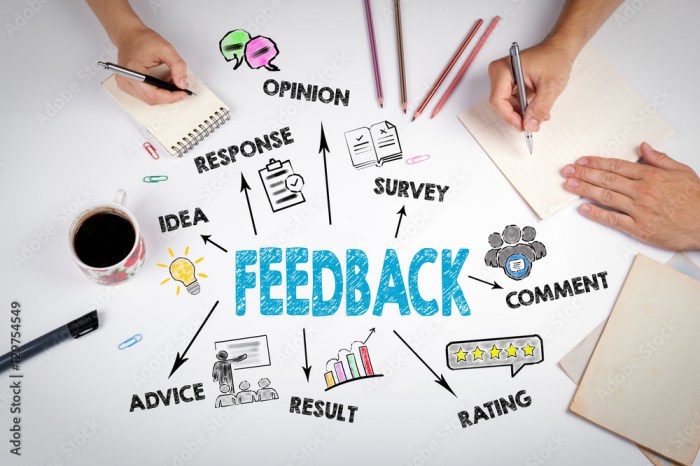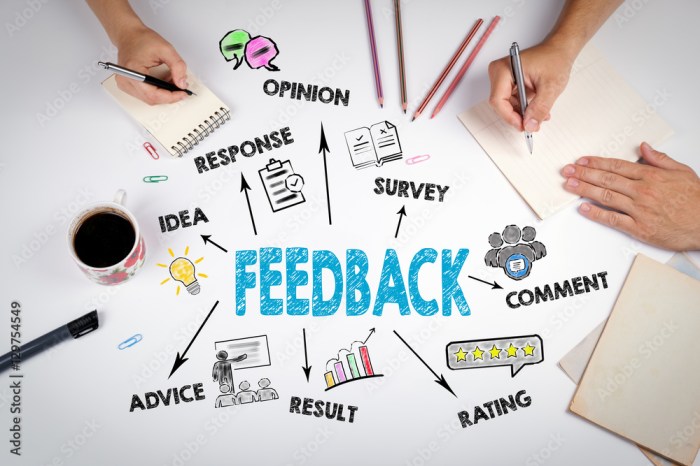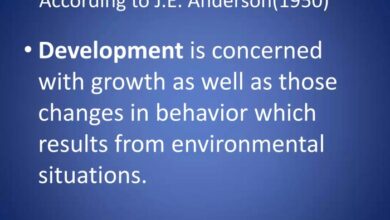
Why you should get meeting feedback is a crucial aspect of team development. Effective meetings are the cornerstone of productivity, collaboration, and growth. Constructive feedback provides valuable insights into how meetings are performing, enabling teams to enhance communication, optimize efficiency, and identify areas for improvement. This means that understanding the impact of your meetings and using feedback effectively will improve your team’s performance, fostering a more productive and engaging work environment.
This insightful guide delves into the numerous benefits of soliciting feedback on meetings, exploring how it enhances communication, boosts efficiency, and drives team growth. We’ll cover everything from identifying communication breakdowns to fostering a culture of trust and motivation within your team.
Improved Communication & Collaboration
Meeting feedback is crucial for fostering a strong and productive team environment. It allows for continuous improvement in communication strategies, leading to more efficient and effective collaboration. By actively seeking and incorporating feedback, teams can identify areas needing attention and adapt their communication approaches to optimize outcomes.Effective communication is paramount in any team setting. Misunderstandings and misinterpretations, often stemming from poor communication, can lead to wasted time, missed deadlines, and decreased overall team morale.
Meeting feedback provides a valuable tool for addressing these issues and creating a more collaborative and productive atmosphere.
Enhancing Communication Patterns
Understanding different communication styles within a team is essential for effective feedback implementation. Active listening, clear articulation, and empathy are all crucial components of strong communication. Feedback can help individuals identify and refine their communication style, making interactions more constructive and productive.
Resolving Communication Breakdowns
Feedback can pinpoint specific instances where communication breakdowns occur during meetings. For example, if a team member consistently interrupts others, feedback can help identify this pattern and suggest strategies for more respectful and collaborative dialogue. If someone feels unheard, feedback can shed light on the underlying issue and promote a more inclusive communication style. Conversely, if discussions are too vague, feedback can guide the team towards more concise and focused communication.
Communication Styles and Feedback
Different communication styles benefit from different feedback approaches. A direct communicator may benefit from feedback focused on active listening techniques. A more indirect communicator might find feedback on clarity and directness helpful. Feedback should be tailored to the individual’s communication style to maximize its effectiveness.
Adjusting Communication Strategies
Teams can adjust their communication strategies based on the feedback received. For example, if feedback suggests that presentations are too long, the team can implement strategies to keep discussions concise and focused. If the feedback highlights a need for more visual aids, the team can incorporate these elements into future meetings. These adjustments can significantly improve the overall communication flow within the team.
Feedback Mechanisms for Improvement
Various feedback mechanisms, such as anonymous surveys, post-meeting discussions, or direct feedback from team members, can be employed to gauge the effectiveness of communication. The choice of mechanism depends on the team’s dynamics and the specific communication challenges being addressed. For example, anonymous surveys can encourage more honest feedback, while direct feedback allows for a more nuanced understanding of individual perspectives.
Impact of Poor Communication on Team Output
Poor communication in meetings can negatively impact team output in several ways. For example, if discussions are disorganized or if critical information is missed, it can lead to inefficient decision-making and a delay in project completion. A lack of clarity in meeting goals can also lead to a decrease in team motivation and morale.
Promoting Active Listening
Feedback loops encourage active listening during meetings. By providing a platform for constructive criticism and self-reflection, teams can become more mindful of how they communicate with each other. This active listening approach helps ensure that all team members feel heard and understood.
Clarity and Conciseness in Discussions
Feedback can improve the clarity and conciseness of meeting discussions. If feedback highlights a lack of clarity in presentations or if participants tend to digress, the team can implement strategies for more focused and direct communication. Clearer communication leads to better understanding and more efficient decision-making.
Incorporating Feedback into Future Communication
To effectively incorporate feedback into future team communication, a simple process can be established. This could involve a dedicated section for feedback in meeting agendas, regular check-ins to review communication patterns, and follow-up meetings to address any recurring issues.
Actionable Steps for Teams
- Establish a clear feedback mechanism.
- Schedule regular reviews of communication strategies.
- Actively listen to and incorporate feedback from team members.
- Adjust communication styles based on feedback received.
- Track progress and make adjustments as needed.
This structured approach ensures that feedback is not a one-time event but an ongoing process for continuous improvement in team communication.
Communication Issues and Solutions
| Communication Issue | Feedback Solution |
|---|---|
| Lack of clarity in instructions | Provide detailed, step-by-step instructions and solicit feedback on understanding. |
| Interruptions during meetings | Establish clear ground rules for turn-taking and respectful dialogue; offer feedback on interruption patterns. |
| Disorganized discussions | Introduce structured discussion points and agendas; provide feedback on the effectiveness of the discussion structure. |
| Passive listening | Encourage active listening by asking clarifying questions and seeking feedback on understanding from each member. |
| Poor nonverbal communication | Address body language cues through feedback and encourage active communication of thoughts and emotions. |
This table illustrates common communication issues and corresponding feedback-driven solutions. Implementing these solutions can significantly improve team communication.
Enhanced Meeting Efficiency & Productivity

Meetings are crucial for collaboration and progress, but they can often be inefficient, wasting valuable time and resources. Constructive feedback can transform meetings from time-sucks into productive sessions that drive tangible results. By understanding how feedback impacts meeting efficiency, organizations can optimize schedules, agendas, and outcomes.
Optimizing Meeting Schedules and Agendas with Feedback
Feedback on meeting schedules and agendas allows for adjustments based on real-world experiences. For example, if a meeting consistently runs over, feedback can suggest shorter meeting durations, earlier start times, or adjusting the agenda to remove non-essential items. This proactive approach, informed by feedback, ensures meetings remain focused and on schedule.
Improving Meeting Outcomes and Saving Time
Feedback on meeting outcomes reveals areas for improvement. If a specific discussion point repeatedly stalls or veers off track, feedback can pinpoint the issue and suggest better framing or alternative approaches. By addressing these points through feedback, meetings can produce more tangible outcomes in a shorter time. For instance, a feedback loop on a brainstorming session can reveal ineffective brainstorming techniques, leading to a more effective future meeting.
Reducing Unproductive Meeting Discussions with Feedback
Feedback identifies and addresses unproductive discussions. If members frequently interrupt or monopolize the conversation, feedback can highlight this behavior, fostering a more inclusive and equitable meeting environment. Suggestions to reframe discussion points can also stem from feedback. A structured approach to addressing these issues through feedback is key to maximizing meeting effectiveness.
Focused and Relevant Meeting Content through Feedback
Feedback can ensure that meetings remain focused on the intended objectives. If feedback reveals that a particular agenda item isn’t directly relevant, the meeting can be adjusted to focus on topics that directly impact goals. This adaptability, driven by feedback, ensures that time is invested wisely.
Comparing Feedback Impact on Meeting Duration and Outcomes
Meetings with constructive feedback mechanisms often have shorter durations and more substantial outcomes. When discussions are focused and relevant, meetings conclude promptly, achieving the desired objectives. Conversely, meetings lacking feedback tend to be longer, less focused, and often result in less tangible results. Feedback allows for immediate adjustments and optimization, thus shortening meeting durations while maximizing impact.
Addressing Time-Wasting Behaviors with Feedback
Feedback can directly address specific time-wasting behaviors. For instance, if members consistently arrive late or fail to prepare adequately, feedback can highlight this behavior, motivating positive change. Meetings can benefit from feedback-driven strategies for minimizing these issues.
Fostering a Culture of Meeting Effectiveness with Feedback
Feedback creates a culture of continuous improvement. By consistently soliciting and implementing feedback, a meeting culture is established where efficiency and effectiveness are prioritized. A cycle of continuous improvement through feedback will drive meeting outcomes and save valuable time.
Refining Meeting Procedures with Feedback, Why you should get meeting feedback
Feedback allows for the refinement of meeting procedures. If feedback suggests that a particular meeting format isn’t working, the organization can implement changes. Feedback drives improvements in meeting procedures, leading to better outcomes. Examples of refining procedures include adjusting meeting frequency, incorporating different technology, or re-evaluating meeting formats.
Evaluating and Improving Meeting Effectiveness
A structured process for evaluating meeting effectiveness involves collecting feedback, analyzing it, and implementing improvements. The process should involve clear criteria for assessment and a plan for incorporating feedback into future meetings. A feedback mechanism can ensure continuous improvement. This structured process can include questionnaires, focus groups, or even simple post-meeting discussions.
Enhancing Meeting Efficiency Tools with Feedback
Feedback can enhance existing meeting tools. For example, if a meeting software isn’t intuitive, feedback can help developers improve the platform’s user experience, leading to greater efficiency. Tools like project management software, shared document platforms, and meeting scheduling software can all benefit from feedback.
Getting meeting feedback is crucial for improvement. It’s like a roadmap for making your meetings more productive, and ultimately, more enjoyable for everyone involved. Just like how clickjackers find a lot to like about Facebook, clickjackers find a lot to like about Facebook , understanding how others perceive your meetings can reveal hidden opportunities for streamlining processes and boosting engagement.
That feedback is invaluable in refining your meeting approach and making them truly effective.
Table Comparing Meeting Formats and Feedback Suggestions
| Meeting Format | Feedback Suggestions |
|---|---|
| Standard In-Person Meeting | Encourage active listening, provide specific time limits for each agenda item, and collect feedback immediately following the meeting. |
| Virtual Meeting | Ensure clear audio/video quality, provide a structured agenda, and incorporate interactive elements like polls or Q&A sessions. Encourage clear communication to minimize misunderstandings. |
| Hybrid Meeting | Balance the needs of both in-person and remote participants, ensuring everyone feels heard and engaged. Provide clear instructions and guidelines. |
Identifying & Addressing Areas for Growth

Meeting feedback isn’t just about identifying problems; it’s a powerful tool for fostering growth, both individually and as a team. By actively soliciting and analyzing feedback, we can pinpoint areas needing improvement, celebrate successes, and ultimately enhance the effectiveness of our meetings. This process allows for continuous learning and adaptation, leading to more productive and fulfilling collaborative experiences.Feedback acts as a mirror, reflecting both strengths and weaknesses.
Understanding these aspects allows us to leverage our talents and address our shortcomings, leading to a more harmonious and efficient meeting environment. This is crucial for not just individual development but also for the collective growth of the team.
Identifying Individual and Team Strengths and Weaknesses
Effective feedback helps pinpoint individual strengths and weaknesses in meeting contributions. For example, a participant consistently offering insightful solutions demonstrates a strength in problem-solving. Conversely, a participant who frequently interrupts others might indicate a need for improved active listening skills. At the team level, feedback can highlight patterns of behavior. If meetings frequently lack decisive action items, this signals a potential weakness in the meeting structure or follow-up processes.
Conversely, if team members consistently praise each other’s ideas, this demonstrates a strength in collaboration and encouragement.
Using Feedback to Improve Individual Performance
Feedback can be a powerful catalyst for individual improvement. A constructive comment, such as “Your summaries of the discussion were very helpful,” can reinforce positive behaviors. A more pointed suggestion, like “Try to avoid interrupting others during the discussion,” offers specific guidance for improvement. Individuals should actively seek out feedback from diverse sources, including colleagues, supervisors, and even self-assessment tools.
By reflecting on this feedback, individuals can pinpoint areas needing attention and create actionable plans for development.
Methods for Addressing Team Development Needs
To address team development needs, consider implementing feedback-driven workshops. These sessions can focus on specific skills, such as active listening, constructive criticism, or time management. A facilitator can guide group discussions and provide tailored exercises to strengthen identified weaknesses. Furthermore, team members can collectively brainstorm solutions for improving meeting dynamics, leading to more collaborative and effective interactions.
Improving Individual Leadership Skills in Meetings
Feedback can significantly enhance individual leadership skills. If a leader is identified as not effectively guiding the discussion, feedback can suggest ways to better facilitate the meeting. This might include strategies for encouraging participation from all team members or for clearly defining meeting objectives. Feedback can also highlight opportunities to delegate tasks effectively or to improve the team’s understanding of meeting expectations.
Impact of Different Feedback Styles on Team Learning
The style of feedback significantly impacts team learning. Constructive feedback, focused on specific behaviors and offering actionable suggestions, fosters a positive learning environment. Conversely, overly critical or general feedback can discourage growth and create defensiveness. Feedback should be delivered with empathy and respect, focusing on the impact of actions rather than personal attacks.
Areas of Improvement in Meeting Dynamics
Feedback can highlight specific areas for improvement in meeting dynamics. If meetings often run over time, feedback might suggest strategies for time management or a more structured agenda. If discussions are dominated by a few individuals, feedback can recommend techniques for encouraging quieter participants. If action items are not followed up on, feedback can prompt a review of follow-up processes.
Fostering a Culture of Continuous Improvement
Feedback fosters a culture of continuous improvement by creating a safe space for sharing constructive criticism and suggestions. Regular feedback sessions promote a sense of shared responsibility for meeting effectiveness. This creates an environment where team members feel empowered to contribute ideas and actively work towards improving future meetings.
Tailoring Training Programs for Meeting Effectiveness
Feedback can directly inform the design of training programs for meeting effectiveness. If feedback reveals a recurring issue with meeting organization, the training can be tailored to focus on agenda-setting and time management techniques. If there’s a need for better active listening skills, training can incorporate exercises and strategies for improved communication.
System for Collecting and Analyzing Feedback
To ensure the system’s effectiveness, feedback should be collected from multiple sources, including attendees, facilitators, and even observers. This can be achieved through anonymous surveys, feedback forms, or even informal check-ins. Collected data should be analyzed to identify recurring themes and patterns. Tools like spreadsheets or online platforms can be utilized to compile and analyze this data effectively.
Resources for Using Feedback for Growth
Various resources offer support for leveraging feedback for growth. Books on communication skills, leadership development, and meeting facilitation can provide valuable insights. Online courses and workshops can provide practical training in specific areas. Professional development organizations often offer programs focused on meeting management and leadership.
Table of Individual Roles in Meetings and Feedback Strategies
| Role | Suggested Feedback Strategies |
|---|---|
| Facilitator | Focus on how the facilitator can improve guidance and encourage participation. |
| Active Listener | Highlight the importance of listening attentively and responding thoughtfully to others. |
| Contributor | Encourage clear and concise contributions, emphasizing the importance of supporting team goals. |
| Participant | Provide feedback on their active participation, highlighting areas of improvement or strengths. |
Building Trust & Rapport: Why You Should Get Meeting Feedback
Constructive feedback is more than just pointing out areas for improvement; it’s a powerful tool for fostering trust and strengthening relationships within teams. A culture of open and honest feedback creates a safe space for team members to learn, grow, and collaborate effectively. This environment, in turn, significantly boosts team performance and morale.Providing and receiving feedback with respect and empathy is crucial for building rapport and fostering a positive team dynamic.
It’s about understanding perspectives, acknowledging strengths, and collaboratively identifying areas for improvement. By actively listening and responding thoughtfully, teams can build a foundation of trust and mutual respect.
Impact of Feedback on Trust
Feedback, when delivered and received constructively, significantly strengthens trust and respect among team members. It demonstrates a commitment to growth and development, showing that the team values each individual’s contribution and is invested in their success. This, in turn, fosters a sense of psychological safety, allowing team members to express their ideas openly without fear of judgment.
Strategies for Delivering Feedback Respectfully
Delivering feedback respectfully involves focusing on specific behaviors and their impact rather than personal attacks. Frame feedback in a way that highlights both the positive and negative aspects of a situation. For example, instead of saying, “Your presentation was disorganized,” try, “I noticed the presentation flowed a bit unevenly. Perhaps organizing the main points into three distinct sections would make it more impactful.” Active listening and empathy are key elements in this process.
Getting feedback on your meetings is crucial for improvement. Just like how seemingly well-intentioned individuals can fall prey to security vulnerabilities, sometimes seemingly flawless meetings have hidden flaws. For example, poor communication or unclear objectives can lead to wasted time and resources, similar to how weak security protocols can leave you vulnerable to breaches. Reading up on how “why bad security can happen to good people” here will offer insight into the unexpected.
Ultimately, feedback helps you refine your meeting processes, leading to more productive and efficient interactions.
- Focus on specific behaviors rather than personal traits. This avoids generalizations and ensures the feedback is targeted and actionable.
- Provide constructive criticism alongside positive reinforcement. Balancing feedback helps maintain motivation and encourages continued improvement.
- Use “I” statements to express your perspective without placing blame. For example, “I felt the meeting was less productive due to…” instead of “You made the meeting less productive…”
- Encourage two-way communication. Create space for questions and discussion, fostering a collaborative environment where team members can understand and address concerns.
Strategies for Receiving Feedback Effectively
Receiving feedback effectively involves actively listening and seeking clarification when needed. Try not to get defensive, and instead, focus on understanding the feedback giver’s perspective. Ask questions to gain further insights and to ensure you fully grasp the message. Use the feedback as an opportunity for growth and improvement.
- Actively listen to the feedback without interrupting.
- Ask clarifying questions to ensure understanding.
- Paraphrase the feedback to confirm your comprehension.
- Thank the feedback giver for their input.
Positive vs. Negative Feedback
Positive feedback reinforces desired behaviors and strengthens the positive team dynamic. It boosts morale, motivation, and encourages continued effort. Negative feedback, when delivered constructively, can highlight areas for improvement and promote growth. However, negative feedback can be counterproductive if delivered in a harsh or judgmental manner. The focus should always be on improvement, not on criticizing individuals.
Building Rapport Through Feedback
Feedback creates a safe space for open communication and honest dialogue. It helps team members understand each other’s perspectives, fostering a stronger sense of rapport and connection. By actively seeking and providing feedback, teams build trust, enhance communication, and work together more effectively.
Feedback and Psychological Safety
Feedback plays a crucial role in fostering psychological safety in meetings. When team members feel safe to share their ideas and opinions without fear of judgment or ridicule, open communication flourishes. Constructive feedback creates an environment where risks are taken, creativity is encouraged, and learning thrives.
Creating a Feedback Culture
A feedback culture that promotes trust and respect involves establishing clear guidelines and expectations for delivering and receiving feedback. This includes regular feedback sessions, training on feedback techniques, and creating a safe space for open dialogue. Team members should feel comfortable providing and receiving feedback without fear of repercussions.
- Establish clear guidelines and expectations for feedback.
- Provide training on feedback techniques for all team members.
- Encourage a culture of continuous improvement.
- Recognize and reward those who provide and receive feedback effectively.
Acknowledging Feedback Contributions
Acknowledging and appreciating feedback contributions is vital for maintaining a positive and supportive team environment. Publicly recognizing the efforts of those who offer feedback, both positive and constructive, fosters a culture of appreciation and encourages future contributions. This creates a positive feedback loop that benefits everyone.
Getting feedback on your meetings is crucial for improvement. It’s like a diagnostic tool, helping you pinpoint areas where you could be more effective. For instance, recent news about the HPS new palm reading a lot like the old palm here highlights how familiar patterns can still be valuable, just as constructive feedback can help you refine your meeting approach.
Ultimately, seeking feedback is a proactive step towards running more productive and impactful meetings.
- Thank individuals for their feedback.
- Publicly acknowledge and appreciate contributions.
- Implement systems for recognizing feedback givers and recipients.
“Feedback is the breakfast of champions.” – Unknown
Motivating & Engaging Team Members
Feedback is a powerful tool for fostering a positive and productive work environment. By actively incorporating feedback into team dynamics, we can create a culture of continuous improvement and growth. This approach goes beyond simply addressing shortcomings; it’s about recognizing achievements, boosting morale, and empowering team members to perform at their best.Understanding how feedback directly impacts team motivation is crucial.
Positive reinforcement, tailored recognition, and constructive criticism, when delivered effectively, can significantly increase team engagement and productivity. It fosters a sense of belonging, ownership, and shared responsibility, ultimately leading to a more cohesive and high-performing team.
How Feedback Motivates Team Members
Effective feedback is not just about identifying areas for improvement; it’s a vital component of motivating team members. It provides clear expectations, reinforces positive behaviors, and creates a safe space for growth. Constructive feedback, when delivered with empathy and respect, empowers individuals to understand their strengths and weaknesses, leading to enhanced performance and increased confidence.
Examples of Positive Feedback Enhancing Team Morale
Positive feedback directly impacts team morale. For instance, recognizing a team member’s exceptional problem-solving skills during a critical project phase can boost their confidence and inspire others. Similarly, acknowledging a team’s collective effort in successfully launching a new product can significantly enhance team spirit and collaboration. These examples demonstrate how specific praise can elevate team morale.
Methods for Incorporating Feedback into Team Motivation Strategies
Implementing feedback into team motivation strategies requires a multi-faceted approach. Regular one-on-one check-ins allow for personalized feedback, fostering a sense of individual support and development. Team-wide feedback sessions, following a project, can highlight collective achievements and identify areas for improvement, promoting a shared understanding. Feedback forms, used to collect input on meeting effectiveness, can be a valuable tool to improve future meeting participation.
Feedback and Active Participation in Meetings
Feedback directly impacts active participation in meetings. When team members feel heard and valued, they are more likely to contribute actively. Constructive criticism about specific contributions can motivate individuals to refine their communication style and present ideas more effectively. Recognizing and appreciating thoughtful contributions encourages continued engagement.
Comparison of Different Feedback Approaches on Team Engagement
Different feedback approaches have varying effects on team engagement. A direct, yet supportive approach, focusing on specific behaviors and their impact, tends to be more effective than general praise. While general praise might feel nice, it often lacks the specific detail necessary for learning and improvement. Providing concrete examples and actionable suggestions for improvement enhances team members’ understanding of what they did well and where they can improve.
Behaviors in Meetings That Feedback Can Boost Motivation
Feedback can positively impact various meeting behaviors. Encouraging active listening, clear communication, and concise contributions are critical. Recognizing the value of diverse perspectives and fostering a safe environment for sharing ideas and suggestions will significantly improve team engagement. Constructive criticism about specific communication barriers can encourage more thoughtful and insightful contributions.
Feedback and Ownership/Responsibility
Feedback fosters a sense of ownership and responsibility within teams. By connecting individual contributions to overall team success, feedback empowers team members to take ownership of their roles and responsibilities. When feedback is tied to specific goals and objectives, team members feel a sense of accountability and are more likely to actively contribute to achieving those goals.
Celebrating Achievements with Feedback
Feedback is crucial for celebrating achievements in meetings. Publicly acknowledging and appreciating accomplishments reinforces positive behaviors and motivates team members. High-performing teams consistently incorporate feedback into recognition strategies, rewarding not only individual but also collective successes.
Reward System Using Feedback
A reward system based on feedback can be designed to recognize and appreciate team members. This system can use feedback to identify outstanding contributions, both individual and collective, and reward them accordingly. This could include public recognition, extra time off, or small gifts.
Team-Building Activities Incorporating Feedback
Team-building activities can be designed to incorporate feedback elements. For example, activities focusing on collaborative problem-solving or communication skills can be followed by feedback sessions to discuss what worked well and what could be improved. This helps to foster a culture of continuous learning and improvement.
Feedback Types and Motivational Approaches
| Feedback Type | Motivational Approach |
|---|---|
| Positive Reinforcement | Highlighting strengths and successes; offering specific praise |
| Constructive Criticism | Providing specific examples of areas for improvement, focusing on behaviors rather than personality |
| Appreciative Inquiry | Focusing on positive aspects and building upon them; seeking to understand what is working well |
| 360-degree Feedback | Gathering input from multiple sources to gain a comprehensive understanding of performance; facilitating self-reflection |
Final Conclusion
In conclusion, embracing meeting feedback is an investment in your team’s overall success. By actively seeking and implementing constructive criticism, teams can build stronger communication, optimize efficiency, and identify areas for personal and collective growth. This proactive approach not only enhances individual performance but also fosters a more collaborative and productive work environment. Ultimately, incorporating feedback into your meetings is a key to unlocking a more successful and motivated team.






